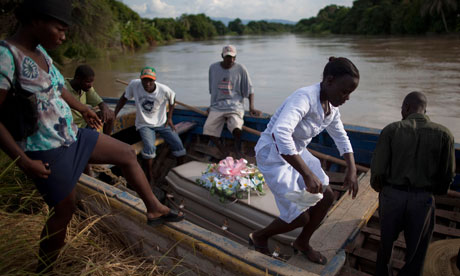The GuardianUK:The overwhelming evidence is that the UN force in Haiti caused the cholera that has killed thousands: a highly symbolic tragedy.

How much is a Haitian life worth to the UN? Apparently, not even an apology.
On 6 August, a unit of the 12,000 member United Nations Stabilisation Mission in Haiti (Minustah) based in the central plateau city of Hinche was caught dumping faeces and other waste in holes a few feet from a river where people bathe and drink. After complaints by locals and an investigation by journalists, city officials burned the waste near the Guayamouc river. The mayor of Hinche, André Renaud, criticised Minustah’s flagrant disregard for the community’s health and called for the expulsion of some foreign troops.
On 21 August, the UN was again accused of improper sewage disposal, 10 miles from Hinche.
As is their wont, Minustah officials simply deny dumping sewage. Last week, the UN released a statement claiming they had no reason to dump waste since the base in Hinche built a treatment plant and sewage disposal on 15 June.
“The United Nations Mission for Stabilisation in Haiti (Minustah) formally denies being responsible for the dumping of waste in Hinche or elsewhere in the territory of Haiti.”
For anyone who has followed Minustah’s operations this denial rings hollow. Ten months ago, reckless sewage disposal at the UN base near Mirebalais caused a devastating cholera outbreak (pdf). In October 2010, a new deployment of Nepalese troops brought the water-borne disease to Haiti that has left 6,200 dead and more than 438,000 ill.
The back story to this affair is that the waste company managing the base, Sanco Enterprises SA, disposed of faecal matter from the Nepalese troops in pits that seeped into the Artibonite River. Locals drank from the river, which is how the first Haitians became infected with cholera. Officials for the UN and the contractor have passed the blame back and forth: the former saying the contractor is responsible for the dump site; the latter saying the UN and a previous contractor established the “procedures” for waste management.
Despite a mountain of evidence collected from local and international researchers, the UN refuses to take responsibility for the cholera outbreak. A November investigation by prominent French epidemiologist, Renaud Piarroux, pointed to the Nepalese troops as the probable origin of the cholera strain, as did a study published by the journal of the US Centre for Disease Control and Prevention and an investigation by Nepalese, Danish and Americans researchers at the Translational Genomics Research Institute in Arizona. Released last Tuesday, the latter study showed that the genomes of bacteria from Haitian cholera patients were virtually identical with those found in Nepal when the peacekeepers left their country in 2010.
A week ago, Minustah spokesperson Vincenzo Pugliese said the international organisation was aware of the new study but maintained that “we follow the recommendations of the report released by the group of experts appointed by the secretary general.” That report refused to pinpoint any single source for the cholera outbreak, concluding it was caused by a “confluence of circumstances”.
The debate over cholera’s origin takes places as the disease continues to ravage the country. In June, the beginning of the rainy season, there were a shocking 1,800 new cases per day.
Despite the ongoing impact of cholera and widespread anger at Minustah over the issue, the UN’s sewage disposal has been of little interest to the international media. Recently, the weekly Haiti Liberté published a picture of a UN vehicle dumping sewage into a river on its front page, but an English-language Google search found no reports in the global press about the criticism towards the international organisation’s waste disposal (aside from passing mentions in the leftist San Francisco Bay View and Truthdig).
Media indifference to the UN’s lax health standards is mirrored in the aid world. Supposedly concerned with Haitian well-being, the innumerable foreign NGOs working in Haiti have said little about Minustah’s waste disposal and disregard for public health. In fact, when the cholera outbreak began, various international humanitarian organisations belittled those calling for an investigation into its source.
A few weeks after the outbreak, Médecins Sans Frontières’ head of mission in Port-au-Prince, Stefano Zannini, told Montreal daily La Presse, “Our position is pragmatic: to have learnt the source at the beginning of the epidemic would not have saved more lives. To know today would have no impact either.” For their part, Oxfam criticised those who protested the UN bringing a disease with no recorded history in Haiti. “If the country explodes in violence, then we will not be able to reach the people we need to”, an Oxfam spokeswoman, Julie Schindall, told the Guardian after the outbreak.
Rather than support calls for greater accountability, the NGOs jumped to the UN’s defence. Highly dependent on western government funding and political support, NGOs are overwhelmingly focused on a charitable model that fails to challenge the political or economic structures that cause the poverty and illness they seek to cure. But without political pressure, the practices that engender poverty and illness will continue, a point driven home with the UN’s waste disposal and cholera. With no oversight, let alone penalty, Minustah will continue to dispose of waste however it sees fit.
So, how many Haitians must die before Minustah stops its dumping of sewage, reckless of public health? Besides immediately halting this dangerous practice, the force should apologise for introducing cholera to Haiti. And to make that apology meaningful, the UN should compensate Haitians by making the country cholera-free through massive investments in the country’s sanitation and sewage systems.